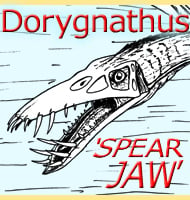In Depth
Apachesaurus was a member of the Metoposauridae group of temnospondyl amphibians, though one that was particularly small. The larger close relatives of Apachesaurus include Metoposaurus and Koskinonodon which could grow up to two and a half to three meters long. Apachesaurus however grew only to around just over forty centimetres long.
Due to the smaller size, Apachesaurus were probably predators of smaller aquatic organisms. Like other related genera, the eyes were placed further forward on the skull that those of other temnospondyl amphibians. Fossils of Apachesaurus are particularly well known from the states of Arizona and New Mexico where individuals have been found in concentrations. This seems to be a recurring theme that Apachesaurus shares with its relative genera, and the explanation is that metoposaurids were not very good at walking on land, so when pools of water and rivers dried out, they were left exposed to the air where they too dried out and died from lack of water.
Further Reading
- Revision of the Metoposauridae (Amphibia: Temnospondyli) and description of a new genus from Western North America - A. P. Hunt - 1993. - Late Triassic (Carnian and Norian) tetrapods from the southwestern United States - R. A. Long & P. A. Murry - 1995.










